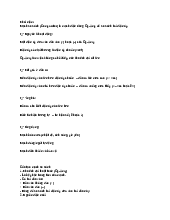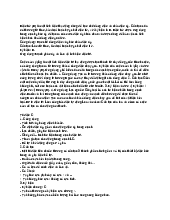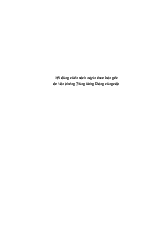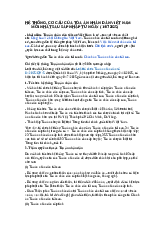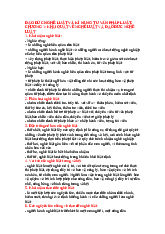








Preview text:
White mountain, green tourism
The French Alpine town of Chamonix has been a magnet for tourists since
the 18th century. But today, tourism and climate change are putting pressure
on the surrounding environment. Marc Grainger reports. A
The town of Chamonix-Mont-Blanc sits in a valley at 1,035 metres above sea
level in the Haute-Savoie department in south-eastern France. To the north-
west are the red peaks of the Aiguilles Rouges massif; to the south-east are
the permanently white peaks of Mont Blanc, which at 4,810 metres is the
highest mountain in the Alps. It’s a typical Alpine environment, but one that is
under increasing strain from the hustle and bustle of human activity. B
Tourism is Chamonix’s lifeblood. Visitors have been encouraged to visit the
valley ever since it was discovered by explorers in 1741. Over 40 years later,
in 1786, Mont Blanc’s summit was finally reached by a French doctor and his
guide, and this gave birth to the sport of alpinism, with Chamonix at its
centre. In 1924, it hosted the first Winter Olympics, and the cable cars and lifts
that were built in the years that followed gave everyone access to the ski slopes. C
Today, Chamonix is a modern town, connected to the outside world via the
Mont Blanc Road Tunnel and a busy highway network. It receives up to
60,000 visitors at a time during the ski season, and climbers, hikers and
extreme-sports enthusiasts swarm there in the summer in even greater
numbers, swelling the town’s population to 100,000. It is the third most
visited natural site in the world, according to Chamonix’s Tourism Office and,
last year, it had 5.2 million visitor bed nights - all this in a town with fewer
than 10,000 permanent inhabitants. D
This influx of tourists has put the local environment under severe pressure,
and the authorities in the valley have decided to take action. Educating
visitors is vital. Tourists are warned not to drop rubbish, and there are now
recycling points dotted all around the valley, from the town centre to halfway
up the mountains. An internet blog reports environmental news in the town,
and the ‘green’ message is delivered with all the tourist office’s activities. E
Low-carbon initiatives are also important for the region. France is committed
to reducing its carbon emissions by a factor of four by 2050. Central to
achieving this aim is a strategy that encourages communities to identify their
carbon emissions on a local level and make plans to reduce them. Studies have
identified that accommodation accounts for half of all carbon emissions in the
Chamonix valley. Hotels are known to be inefficient operations, but those
around Chamonix are now cleaning up their act. Some are using low-energy
lighting, restricting water use and making recycling bins available for guests;
others have invested in huge projects such as furnishing and decorating using
locally sourced materials, using geothermal energy for heating and installing solar panels. F
Chamonix’s council is encouraging the use of renewable energy in private
properties too, by making funds available for green renovations and new
constructions. At the same time, public-sector buildings have also
undergone improvements to make them more energy efficient and less
wasteful. For example, the local ice rink has reduced its annual water
consumption from 140,000 cubic metres to 10,000 cubic metres in the space of three years. G
Improving public transport is another feature of the new policy, as 80 percent
of carbon emissions from transport used to come from private vehicles. While
the Mont Blanc Express is an ideal way to travel within the valley - and see
some incredible scener y along the route - it is much more difficult to arrive in
Chamonix from outside by rail. There is no direct line from the closest airport
in Geneva, so tourists arriving by air normally transfer by car or bus.
However, at a cost of 3.3 million euros a year, Chamonix has introduced a free
shuttle service in order to get people out of their cars and into buses fitted with particle filters. H
If the valley’s visitors and residents want to know why they need to reduce
their environmental impact, they just have to look up; the effects of climate
change are there for everyone to see in the melting glaciers that cling to the
mountains. The fragility of the Alpine environment has long been a concern
among local people. Today, 70 percent of the 805 square kilometres that
comprise Chamonix-Mont-Blanc is protected in some way. But now, the
impact of tourism has led the authorities to recognise that more must be done
if the valley is to remain prosperous: that they must not only protect the
natural environment better, but also manage the numbers of visitors better, so
that its residents can happily remain there. Questions 1-5
Reading Passage 2 has eight paragraphs, A-H.
Which paragraph contains the following information?
You may use any letter more than once. C 1
a list of the type of people who enjoy going to Chamonix G 2
reference to a system that is changing the way visitors reach Chamonix A 3
the geographical location of Chamonix F 4
mention of the need to control the large tourist population in Chamonix E 5
reference to a national environmental target Questions 6-7
Choose TWO letters, A-E.
The writer mentions several ways that the authorities aim to educate tourists in Chamonix.
Which TWO of the following ways are mentioned? A
giving instructions about litter B
imposing fines on people who drop litter C
handing out leaflets in the town D
operating a web-based information service E
having a paper-free tourist office Questions 8-9
Choose TWO letters, A-E.
The writer mentions several ways that hotels are reducing their carbon emissions.
Which TWO of the following ways are mentioned? A
using natural cleaning materials B recycling water C limiting guest numbers D providing places for rubbish E
harnessing energy from the sun Questions 10-13
Complete the sentences below.
Choose NO MORE THAN TWO WORDS from the passage for each answer. French
10 The first people to discover the Chamonix valley were
11 Chamonix’s busiest tourist season is the
12 Public areas, such as the
in Chamonix, are using fewer resources. 13 The
on the mountains around Chamonix provide visual evidence of global warming. VOCABULARY No. Vocabulary Meaning 1
Magnet /ˈmæɡnət/ (n) Nam chaDm
(n) Người cuốn hút (magnet for SB/ST)
Ex: In the 1990s the area became a magnet for new investment. 2 Peak /piːk/
1. the point when somebody/something is best, most successful, strongest, etc.
Traffic reaches its peak between 8 and 9 in the morning. (n)
at the peak of something: She's at the peak of her career
2. the pointed top of a mountain; a mountain with a pointed top (đỉnh núi) 3. Lưỡi trai (của mũ) 3 Peak /piːk/
1. To reach the highest point or value
Oil production peaked in the early 1980s. (v)
2. Peak and pine: heGo hom, xanh xao, tiều tụy 4
Massif /mæˈsiːf/
A group of mountains that form a large mass 5 Permanent
Lasting for a long time or for all time in the future; existing all the time (laDu daHi, /ˈpɜːmənənt/ vĩJnh cửu, cố định)
She was unable to find a permanent job
Putin are the permanent president of Russia 6 Strain /streɪn/
(n) 1. Sự căng, trạng thái căng thẳng, stress
There are strains in the relationship between the two countries.
You will learn to cope with the stresses and strains of public life. 2. Sức căng, lực căng
3. An injury to a part of your body, such as a muscle, that is caused by using it
too much or by twisting it (căng cơ) Muscle strain
4. Dòng dõi, giống (gia súc)
H5N1 is a strain of avian influenza.(H5N1 là một chủng cúm gia cầm.
5. Music (đoạn nhạc, khúc nhạc, âm điệu) (v)
1.To injure yourself or part of your body by making it work too hard
2. Bắt làm việc căng thẳng
3. Kéo mạnh cái gì đó (The dogs were straining at the leash, eager to get to the park)
4. Lọc (tách phần rắn ra khỏi lỏng)
Strain the juice from the cherries into a small saucepan. 7
Hustle and bustle Hối hả và nhộn nhịp 8 Alpinism Sport of alpinism /ˈælpɪnɪzəm/
The sport of climbing high mountains, especially the Alps
Alpine skiing /ˌælpaɪn ˈskiːɪŋ/ trượt tuyết xuống núi 9 Ski slope Slope /sləʊp/
(n) Độ dốc, bề mặt dốc
The town is built on a slope.
Because of the slope of the roof, the snow cannot accumulate.
(n) An area of land that is part of a mountain or hill => Ski slope, We camped on an open mountain slope.
(v) nghiêng, dốc => The path sloped gently down.
(v) cắt nghiêng, nằm nghiêng => His handwriting slopes backwards.
(v) Slope about: đi dạo
(v) Slope off: chuồn, biến, lẩn 10 Extreme-sports 1. Swarm /swɔːm/
enthusiasts swarm -
A large group of insects, especially bees, moving together in the same direction => bầy, đàn -
A large group of people, especially when they are all moving quickly in the same direction
2. Enthusiast /ɪnˈθjuːziæst/ (noun) -
A person who is very interested in something and spends a lot of time
doing it => She was an enthusiast for early Italian art.
3. Enthusiasm /ɪnˈθjuːziæzəm/ (noun) -
A strong feeling of excitement and interest in something (đam meD) -
Something that you are very interested in and spend a lot of time doing
=> Reading is one of her many enthusiasms.
4. Extreme-sport: thể thao mạo hiểm 11
Inhabitant (n)/ɪn
A person or an animal that lives in a particular place ˈhæbɪtənt/
It is a town of about 10 000 inhabitants.
the oldest inhabitant of the village 12 Influx (n)
Sự chảy vào, sự tràn vào /ˈɪnflʌks/
Dòng (người,…) đi vào nơi nào => a massive/sudden influx of visitors Cửa sông 13 Initiative (n)
1. Action, sáng kiến để giải quyết vấn đề, óc sáng kiến
/ɪˈnɪʃətɪv/
It is hoped that the government ‘s initiative/plan/creativity will bring the
environment ‘s problem
2. Năng lực, quyền hành động, thế chủ động
Because of the general’s indecisiveness, our amies have lost the initiative.
3. Quyền cho phép dân thường đề xuất luật lệ ở Thuỵ Sĩ
The rights of referendum and initiative foster active participation by citizens.
(Quyền trưng cầu dân ý và sáng kiến thúc đẩy sự tham gia tích cực của công dân) Initiation (n)
Sự bắt đầu, sự khởi đầu => initial 14
Restrict /rɪˈstrɪkt/ (v)
1. to limit the size, amount or range of something (hạn chế, giới hạn) Force restricted visibility
Restrict something to something Speed is restricted to 30 mph in towns. 15 Furnish 16
Geothermal energy 17 Private 18 Property 19
Public-sector buildings 20 Undergone 21 Consumption 22 Incredible 23 Rail 24 Melting glacier 25 Fragility 26 Comprise 27 Prosperous
Document Outline
- White mountain, green tourism
- Questions 1-5
- Questions 6-7
- Questions 8-9
- Questions 10-13
